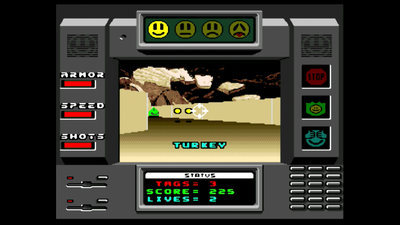

However, going along with what jgkspsx said, the polygonal 3d with scaling and rotation was damn impressive, borderline mind blowing and left any other handheld in the dust. Nope, as you pointed out its better resolution and framerate. Now, was the Lynx completely superior to the GG. But, the GG was really just a slightly hopped up Master System whereas the chipset in the Lynx was really something special to be seen on a handheld in the late 80s and/or early 90s. Granted, the GG was an impressive machine in its own right. But, in 1991, Warbirds on the Lynx was doing 3D effects that were on par (to a large but not complete extent) only really available on computers. Granted, both Blue Lightning and/or Warbirds are not the most fully fleshed out games on there. There is no way in hades that the GG can do what the Lynx can with Blue Lightning, or even one of my personal favorites Warbirds. (Actually, given that GB Faceball runs better than GG, maybe that is the case…)

Either that or the folks who programmed Faceball weren’t the best.
FACEBALL 2000 GAME GEAR FULL
The full polygonal 3D of Steel Talons and Hard Drivin’ or the open worlds of Battlewheels or Cybervirus would be impossible to do on a handheld (Nomad excepted) until the GBA. The scaling performance in Blue Lightning blows away almost every Genesis Super Scaler port, much less the Turbografx’s badly compromised Afterburner II etc or especially the Game Gear’s sad attempts like G LOC and Space Harrier (which, I will grant, is a ton of fun despite being graphically not much to look at). The GG was far from perfect, titles often had to be substantially reworked for it, but it's just daft to claim the Lynx conquered all before it, in all areas.
FACEBALL 2000 GAME GEAR SOFTWARE
The Lynx was an amazing system yes, but as you say, both the GB and GG beat it in resolution, the GG beat it on number of colours on screen as standard (Lynx had to use clever software routines to get more than 16 colours on screen), Lynx not ideally suited for platform games. ? It's been a personal gripe of mine for years when I would read comments from Atari Fans, that the Lynx hardware was never beaten until the arrival of the GBA. Yes, John clipped the left and right side of the Lynx video, so it would be wider, but that's just viewable area - and not pixel size dependent (these are all square pixels with no PAR adjustment). To put it into perspective the pixels on the Lynx are 38.5% larger (tall and wide) than the GG! And you can clearly see it in this video comparison. is that the GG (and GB) are higher resolution than the Lynx. Source: Wikipedia, " Faceball 2000", available under the CC-BY-SA License.I know this video is for FPS comparison, but the other thing no one seems to talk about. All players were shown as smilies in various colors. The game area itself occupied only roughly a quarter of the screen and consisted of a first person view of a flat-shaded Pac-Man-like maze with a crosshair in the middle. Graphically the game was very simple with a humorous twist. The SNES version substituted completely different graphics and levels from the earlier GameBoy version. It owes a significant debt to what may be the first of its genre, Maze War.Ī Game Boy version was developed by the original developers, Xanth Software F/X, and published in 1991 by Bulletproof Software, now Blue Planet Software, under the title Faceball 2000.Ī SNES version, also programmed by Robert Champagne, was released the following year, supporting two players in split-screen mode.

MIDI Maze was an early first person shooter video game for the Atari ST developed by Xanth Software F/X, published by Hybrid Arts, and released around 1987.


 0 kommentar(er)
0 kommentar(er)
